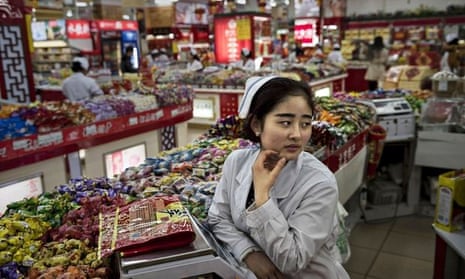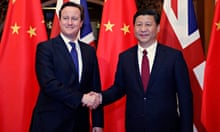China’s president, Xi Jinping, calls it the “new normal” – but strikes are increasing, wages going unpaid and businesses are struggling to survive as the vast economy adjusts to a more sedate pace of growth after more than a decade of explosive expansion.
Official figures published last week showed that China’s GDP expanded by 7.4% in 2014. That was a significant drop from the 7.7% seen in 2013, and the weakest rate of growth since 1990, when the country was grappling with international sanctions in the wake of the Tiananmen Square massacre.
And while the government has spun the downturn as a good thing, as it deliberately shifts from an unsustainable, export-led boom to relying on demand at home to fuel economic growth, people across the country are feeling the heat.
Coal and copper prices are down owing to lack of demand; strikes and protests are becoming increasingly common. The prospect of weaker demand from China has also been a key factor behind plunging global oil prices.
“From an industry point of view, obviously the hardest hit are the miners and the upstream players – the iron ore industry, steel, refineries, they’re all being really squeezed,” said Andrew Polk, a senior economist at research group The Conference Board’s China centre for economics and business in Beijing. “China’s consumption has held up relatively well so far, but [the slowdown] looks to be finally feeding through to the consumption side as well.”
And while the downturn is, on one level, intentional, policymakers face a tough challenge in engineering a slowdown while maintaining enough control over the financial system to prevent a crash.
Growth is expected to slow further over the next three years, as officials act to control the sliding property market and rein in excessive borrowing by local government — the International Monetary Fund has projected a 2015 growth rate of 6.8%.
“The financial crisis dealt a mortal blow to the export-led growth model, for two reasons,” said Diana Choyleva, an expert on China at consultancy Lombard Street Research.
“One was the slowdown in global demand, and the other was the adjustment of the yuan against the dollar. Not only has the size of the pie reduced, but their ability to carve out ever-larger parts of it has diminished.” Her analysis of Chinese data suggests growth is actually considerably slower than official figures suggest.
Even China’s middle class, a group that has expanded at breakneck speed and become accustomed to constantly rising living standards over recent years, is starting to feeling the pinch.
On Thursday morning, many shoppers at the Huapu Hypermarket in central Beijing were complaining of tough economic times.
“I’m a businessman, so of course this is affecting me,” said a 36-year-old tobacco and wine wholesaler who gave his name as Mr Ji. His income had dropped as much as 30% over the past year, he said, as he dropped spring onions into his trolley. “I’m starting to think about changing careers.”
A young woman surnamed Chen said that wages at her public sector company were shrinking. “We’re also getting less of a bonus this year – though I’m single, so it’s not so bad,” she said.
Polk at The Conference Board said: “From an industry point of view, one of the ways [the downturn] is going to play out is that wage growth will have to slow. We’re starting to see a convergence between labour productivity and wage growth. When wage growth rises above productivity, companies start to be unprofitable.”
Xi first urged the Chinese public to accept the “new normal” of economic growth while on an inspection tour in Henan province last May. Since then, state media has embraced the term as an assurance that authorities are firmly in control, carefully shedding their growth-at-all-costs mantra for a more equitable approach to development.
Under the new normal, officials say, China’s economy will be fairer and more sustainable, and the country can finally begin making progress towards restoring its environment after decades of wanton pollution.
“The market, crazy about speed and figures, seems to have missed the reality that the Chinese economy is healthier under the ‘new normal’ featuring positive trends of stable growth, an optimised structure, enhanced quality and improved social welfare,” Xinhua, the state news service, said on Wednesday.
At the Davos World Economic Forum on Thursday, China’s prime minister, Li Keqiang, insisted: “China will avoid a hard landing, continue its ongoing reform and restructuring and ensure a prolonged period of sustainable future medium-to-fast growth.”
Yet Chen Xiushan, an economics professor at the Renmin University of China, believes that this “new normal” will mean something very different for, say, an oil worker in far-northern Heilongjiang province than it will to an upwardly mobile tech entrepreneur in Beijing.

The downturn could be devastating for people working in basic commodities such as steel and cement, as the property market continues to sink and the government implements new measures to chip away at overcapacity. Yet other sectors could benefit, as Beijing pumps subsidies into healthcare, tech, and culture industries such as film and music.
Some regions are likely to adjust better to the new growth model, too. Coastal south-east China, an economically diverse region, may blow through the downturn unscathed, Chen Xiushan said, while inland and industrial provinces would almost inevitably struggle. North-east China “does not stand much chance for economic transition,” as its economy leaned heavily on clunky, anachronistic state-owned enterprises and its population was increasingly migrating south in search of work.
Karen Ward, senior global economist at HSBC, said that, for the time being, the authorities were continuing to underpin economic growth with public building projects. “Consumption is still stable and strong, it’s just not big enough: and while exports are a drag, it’s just not filling the void. That’s why they’re still filling the gap with infrastructure spending.”
Experts are divided about this infrastructural spending spree. Some fear the authorities have squandered money on unnecessary projects, reminiscent of the “bridges to nowhere” that came to characterise the Japanese investment bubble of the 1980s. Investment now accounts for more than half of GDP.
But Ward, who is optimistic about the outlook for China, insisted that the country was still in desperate need of infrastructure. “If you look at what they’ve got – sewerage systems for example – they’re still a very poor country. They’re building things that they need. In terms of infrastructure, it looks like Japan in the 1950s, not the 1980s.
“There are sectors that are massively over capacity – steel is definitely one of them. But in the broad scheme of things, are they wasting money to generate growth? That just doesn’t worry me.”
China’s policymakers certainly claim they can avoid a crash. As prime minister Li put it in Davos: “If I could compare the Chinese economy to a running train, what I want you to know is that this train will not lose speed or momentum. It will only be powered by stronger dynamo and run with greater steadiness, bringing along new opportunities and new momentum of growth.”
Choyleva, of Lombard Street Research, pointed out that the gear-change would not be easy. “The new leadership is intent on reform; but their resolve will be tested big-time.”
City economist and China-watcher George Magnus warned last week that the authorities’ resolve to let the slowdown run its course might be severely tested as it started to cause more financial pain for some.
“There is almost certainly a lower limit to growth, at or not too far away from 7%, where official concerns about unemployment and stability will increase — mainly because of the risk this could pose to social stability against a backdrop of a rising level of strikes and other labour unrest.”
Additional research by Luna Lin





Comments (…)
Sign in or create your Guardian account to join the discussion